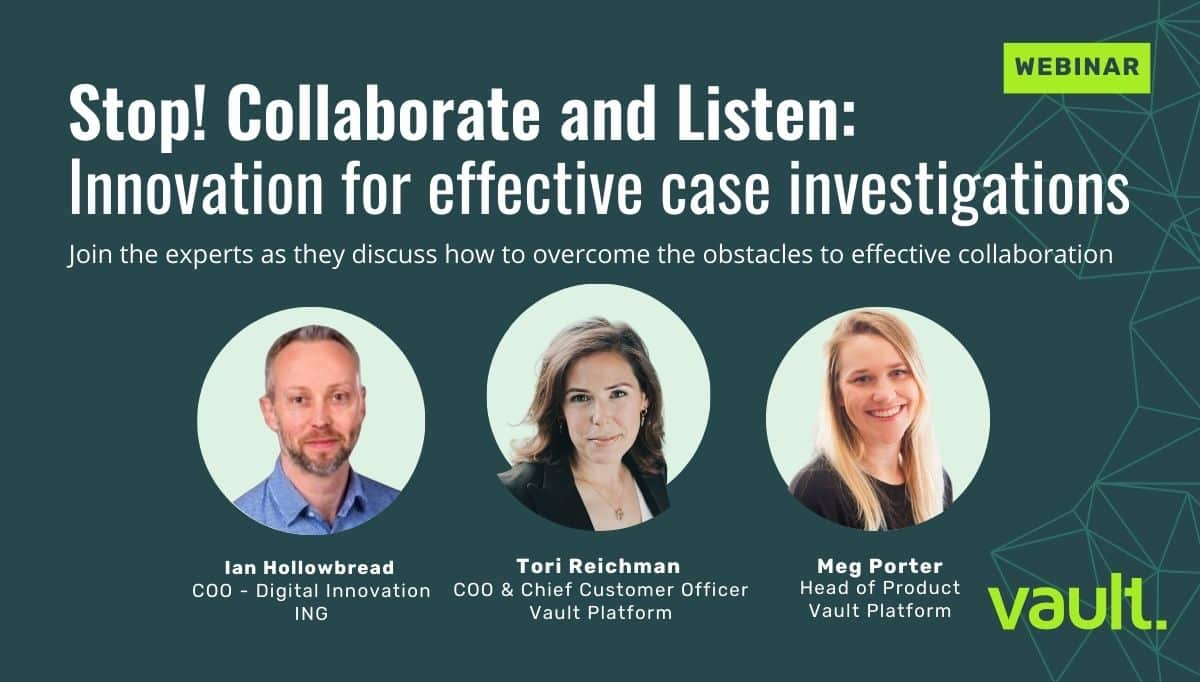
Last week, our CEO Neta Meidav joined law firm Cooley LLP and Damien Atkins, Chief Legal Officer and General Counsel from Aura, for a live webinar to discuss the latest on whistleblower trends, managing investigations, and preparing your company with tech-driven tools. In case you missed it, here are our top six takeaways from the webinar.
1. Upwards Trend
The number of whistleblower complaints is trending upwards, with the Securities and Exchange Commission (SEC) receiving more than 12,000 whistleblower tips from individuals in 99 countries in 2021.
Cooley Partner Russell Capone highlighted that the SEC paid out approximately $564 million to whistleblowers in the 2021 fiscal year alone. During the same period, the Department of Justice (DOJ) recovered over $1.6 billion from False Claims Act actions filed by whistleblowers. In Europe, meanwhile, analysts forecast higher rates of complaints due to the increased whistleblower protections implemented by the EU Whistleblowing Directive (EUWD).
2. A Closer Look at the EUWD
Cooley Partner Ann Bevitt discussed the EUWD in more depth, including why it matters and tips on how to deal with its impact.
The Directive is about setting minimum standards for member states to enact into local law. As this is one of the first wide whistleblowing regulations to be implemented in the Union, Ann highlighted that it may be a steep learning curve for some organizations and easy for them to get wrong.
EU member states must incorporate “effective, proportionate and dissuasive” penalties into implementing laws for individuals/entities that:
- Hinder/attempt to hinder reporting
- Retaliate or bring vexations proceedings against whistleblower
- Breach duty to keep whistleblower’s identity confidential
3. Best Practices for Managing Investigations
Shamis Beckley from Cooley then provided some practical tips for managing investigations, including:
- Take whistleblower allegations seriously
- Keep things confidential (to the extent practicable)
- Stay in contact with the whistleblower (to the extent possible)
- Do not retaliate
- Treat whistleblowers thoughtfully and respectfully
4. How Misconduct Impacts Culture, Reputation and the Bottom Line
Another area discussed at length during the webinar was the importance of having a culture of trust and how organizations can show an openness to misconduct reporting that actually rewards reporters for their efforts.
Pulling data from our game-changing Trust Gap survey, Neta Meidav revealed that half of UK and US office workers personally experience misconduct, but that very few choose to report it.
Neta said: “Organizations have a history of adopting whistleblowing ‘solutions’ that leave anonymous reports unactioned, costing them financially and damaging their reputation.
“One of the major blockers in creating a culture of trust is the hotline – it doesn’t belong in the modern workplace. The choice to report misconduct could be hugely impactful on an employee – potentially career-changing – so the idea of phoning someone with no vested interest in your career isn’t the way to go. Employees don’t want to have a conversation; they want to know who they’re talking to and see action off the back of their report. Incumbent solutions have led many employees to distrust their employers.”
5. Closing the Gap
Another hot topic of the webinar was the changing expectations of employees, who want their organizations to be values-driven and stand up for those values both internally and externally. Organizations need to show that they want their employees to be heard, so should agree on what’s important to them as a business and how to Speak Up about it.
Damien Atkins made it clear that it comes down to the CEO to be the loudest voice driving the importance of ethics, compliance, and company values. This extends not only to policies and procedures but also to how seriously the organization treats reports. Companies that take misconduct reports seriously are willing to get rid of ‘bad apples’ if necessary, regardless of their seniority or experience. They also protect reporters by keeping information confidential, letting them know when action is being taken, and showing their appreciation by rewarding reporters.
He also talked about the importance of employees having a voice at work, as there are now a wealth of communication methods for them to exercise their voice outside of work. It can be damaging to a brand’s reputation if an employee has not been heard internally and so posts about misconduct on social media platforms, such as Twitter.
Workplaces need to offer a range of communication methods that meet the needs of the modern, remote workforce, as the right tools and processes can allow employees to participate and have a voice in the same way they can outside of work.
6. Leveraging Technology
The panel weighed in on why implementing innovative tech-backed whistleblower programs as an internal control is vital to appropriately handle complaints, identify and anticipate patterns and mitigate risk for both employees and employers.
To establish strong compliance programs and accessible reporting outlets for employees, organizations need to adopt solutions that actually work. With the right technology that enables data capture and the ability to connect the dots in order to prevent risks before they happen, organizations can dramatically improve investigation procedures through reduced resolution time and easier collaboration.
To watch the webinar in full, click here.



